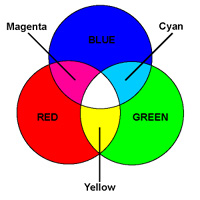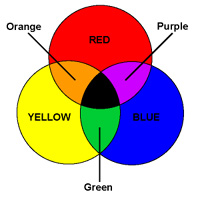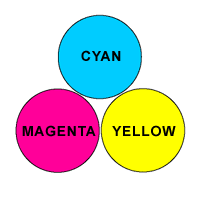Contrary to popular belief, there are actually two types of primary colours.
Additive primary colours and Subtractive primary colours are the only two basic methods to produce colour. To create all the colours of the rainbow, both processes use primary colours, which are colours that cannot be created by mixing other colours.
Additive Primary Colours

Additive colours are colours that are associated with emitted light directly from a source before an object reflects the light. These colours are red, green and blue - (often seen for short as RGB). These are the colours we are probably most familiar with in association with television, and computer displays.
The additive primary colours are red, green and blue.
If all three of the additive colours were combined together in the form of light, they would produce white.
Some examples where additive primary colours are used:
- television
- theatrical lighting
- computer monitors
Read more about additive primary colours
Subtractive Primary Colours

Subtractive colours are colours that are associated with reflected light. In this case the subtractive colours are blue red and yellow. These are the colours we are probably most familiar with the as the primary colours from school.
These colours are associated with the subtraction of light and used in pigments for making paints, inks, coloured fabrics, and general coloured coatings that we see and use every day.
If all three of the subtractive primary colours were combined together, they would produce black.
Read more about subtractive primary colours
Subtractive primary colours differ in the printing process

All printing processes use colours in the form of Cyan (blue) Magenta (red) Yellow and Black. This is known as CMYK for short (cyan, magenta, yellow, black) the 'K' stands for black in the printing process.
These colours: Cyan, Magenta and Yellow are a set of subtractive primaries and are most commonly used by printers. They are commonly referred to as the 'printing primaries'.
It is difficult to achieve a good black from just these colour pigments so printers will sometimes also use black.
The reason that printers use this set of primaries as opposed to the painting primaries of blue, red and yellow, is that they yield far better results. If you are using these colours for painting however, you will find that mixing them is far less intuitive than when mixing the painting primaries.
Some examples where subtractive primary colours are used:
- Textiles
- Clothes
- Furnishings
- Printing
- Paints
- Coloured coatings
